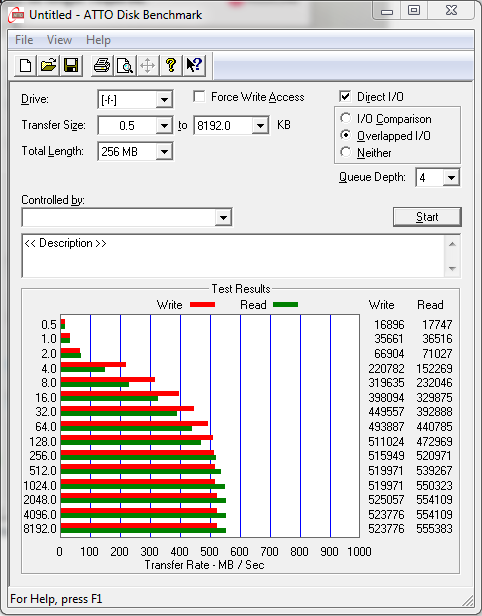ATTO Disk Benchmark is perhaps one of the oldest benchmarks going and is definitely the main staple for manufacturer performance specifications. ATTO uses RAW or compressible data and, for our benchmarks, we use a set length of 256mb and test both the read and write performance of various transfer sizes ranging from 0.5 to 8192kb. Manufacturers prefer this method of testing as it deals with raw (compressible) data rather than random (includes incompressible data) which, although more realistic, results in lower performance results.
 Comay couldn’t get any closer to their listed specifications of 555MB/s read and 525MB/s write which was a very good start to our testing.
Comay couldn’t get any closer to their listed specifications of 555MB/s read and 525MB/s write which was a very good start to our testing.
CRYSTAL DISK BENCHMARK VER. 3.0 X64
Crystal Disk Benchmark is used to measure read and write performance through sampling of raw (0/1 Fill/compressible) or random data which is, for the most part, incompressible. Many new SandForce Driven SSD owners who cant wait to test the performance of their SSD often grab this program and run a quick test, not realizing that they are testing with incompressible data rather than compressible data used in testing by manufacturers. We have provided compressible (oFill) results on the left with incompressible (random data) results on the right.

 For those new to SSDs, the result on right is typical when testing incompressible data and displaying it next to the results of compressible data (left), incompressible data consisting mainly of music files, video and photographs. These results are only indicative of transfer speeds and wouldn’t affect media playback whatsoever. Conversely, excellent low 4k write transfer speeds of 98MB/s give us a heads up that this SSD will be showing some nice numbers as we further our testing.
For those new to SSDs, the result on right is typical when testing incompressible data and displaying it next to the results of compressible data (left), incompressible data consisting mainly of music files, video and photographs. These results are only indicative of transfer speeds and wouldn’t affect media playback whatsoever. Conversely, excellent low 4k write transfer speeds of 98MB/s give us a heads up that this SSD will be showing some nice numbers as we further our testing.
Up until recently, ATTO was the only benchmark created specifically for SSD testing and it uses incompressible data. AS SSD, for the most part, gives us the worst case scenario in SSD transfer speeds because of its use of incompressible data and many enthusiasts like to AS SSD for their needs. Transfer speeds are displayed on the left with IOPS results on the right.

 Our AS SSD results confirm that of which we saw in Crystal DiskMark while testing in incompressible data and go a step further by showing some great disk access speeds. The IOPS results are a bit lower than the specifications list but this is typical of AS SSD.
Our AS SSD results confirm that of which we saw in Crystal DiskMark while testing in incompressible data and go a step further by showing some great disk access speeds. The IOPS results are a bit lower than the specifications list but this is typical of AS SSD.
 The SSD Review The Worlds Dedicated SSD Education and Review Resource |
The SSD Review The Worlds Dedicated SSD Education and Review Resource | 
tbh i was hoping this new pro version SSD would do extremely well, was really looking foward to a sandforce drive out perform the plextor m3pro. currently sandforce drives been doing pretty well with the incompressible data at over 300mb/s but thats just crystaldisk though, which shows the best possible results unlike AS SSD which shows the worst possible result.
quite frankly the lowest results showing in AS SSD for plextorm3p are way too good, and its access time simply amazing lol. sandforced write latency usually around .18-.2 ms, just cant beat marvel/samsung controller.
i’ll probably just wait till something* that has really good 4k speed, something a bit better than the intel 520 drives
you can buy this product with contact iPCZEN.
http://www.ipczeninformatique.fr
I’ve always wondered just how much a supercap adds to the price of an SSD. I suspect very little. These should have been standard on all models, not just the enterprise ones. Just a marketing gimmick to boost prices.
As for access time performance you have to be cautious here. A controller designer can use DRAM as a crutch to boost performance and there is always a tradeoff. In this case it’s an incrfeased risk of data corruption or loss. The large DRAM cache becomes a data integrity risk as well as performance enhancer. Hell, if you used enough DRAM you could achieve RAMDISK performance across the board.
The supercap adds a few $s to the BOM, depending on the size of the cache, and whether the device/controller operates in cache protection mode (which keeps some flash memory erased and ready to accept the contents of the cache).
As for their use of DRAM cache to speed up performance, that’s why CoreRise has used the supercap: You get all the write speed benefits of a large DRAM cache, with no loss of data integrity. The supercap acts as an internal UPS to ensure that there’s time to write all the cache contents to flash after a power loss/interruption.